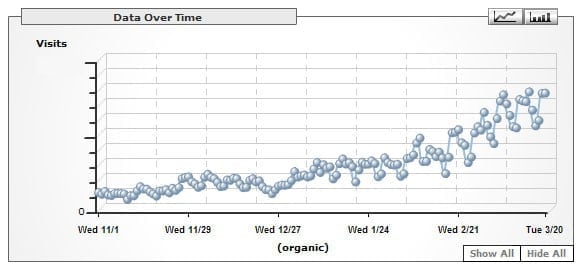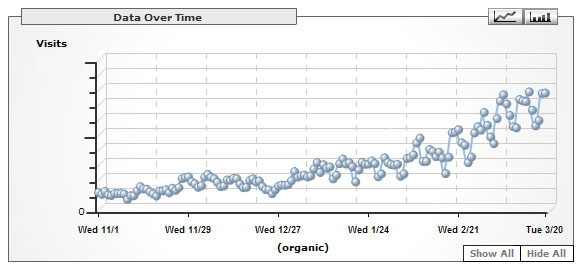 Reading Time: 3 minutes
Reading Time: 3 minutesOne challenge that faces SEO firms is that if you improve organic search traffic for a client, how do you demonstrate how much of the growth you are responsible for?
You could look at the current organic search traffic and compare it to a similar period before you started optimizing the client site. But, that does not take into account the industry-wide trends, economic trends or other underlying trends such as search traffic growth that could be adding to or subtracting from the gains created by your SEO efforts. Also, this method does not take into account any growth trends the client may have been experiencing previously.
So, how do you show your value?
For example, if you are working with a company that sells Widgets and the Widget industry is growing at 4% annually, you might reasonably expect a similar growth in Widget related search terms. However, this is an assumption. New competitors are continually entering the Widget business, including Internet-only companies without inventories or new global competitors. Likewise, existing competitors are investing in their own online marketing efforts to drive organic search traffic growth. In other words, even though the pie is growing, every participant is not guaranteed a slice of that growth. Some companies will even see declines as growth heats up.
That brings us back to the issue. Assuming you are growing your client’s organic search traffic (we hope it is not declining under your watch), how do you show that the SEO Audits, technical and content recommendations you’ve provided are working and and how do you identify industry-specific, seasonal, and keyword search trends?
If you have access to the client’s traffic data over several years, the easiest thing to do would be to look at the past 5-6 years and examine the organic search traffic data to determine the baseline growth rate. If you are seeing a similar rate of organic traffic growth month over month or year over year, calculate the AVERAGE growth rate with some extra weight given to the most recent data as recent history is the most relevant in terms of future projections.
The average growth rate should give you some idea of what sort of growth the client was experiencing on their own. Determining the average annual growth rate is ideal since many industries are seasonal and may be significantly more active at certain times of the year, if interest is relative to the weather, the holiday season, or the school calendar, etc.

In our example of the Widget company, if the company was experiencing organic search traffic growth of 5% annually for the 5 years prior to your SEO efforts, and they are now growing organic search at 25% annually, you can reasonably assume that your work has resulted in a net 20% of the current growth. 20% would be your provable contribution to growth. Your actual contribution is likely to be higher as we are calculating this with the assumption that the client’s baseline trend would have continued, rather than decreased.
If you have access to the data (Comscore, Hitwise, or Compete.com), it would be helpful to see how competing sites are growing organically or the search trends for specific keywords, which will provides clues as to the growth of a particular industry.
At the end of the day, the data will be your friend. This is why baseline rankings and traffic evaluation is so important. Unless you know where your client’s site was before, in terms of keyword rankings, organic search traffic, organic conversions, etc., you will not be able to show them how far you’ve come together as a result of your SEO effort.
At Vizion Interactive, we have the expertise, experience, and enthusiasm to get results and keep clients happy! Learn more about how our SEO Audits, Local Listing Management, Website Redesign Consulting, and B2B digital marketing services can increase sales and boost your ROI. But don’t just take our word for it, check out what our clients have to say, along with our case studies.




